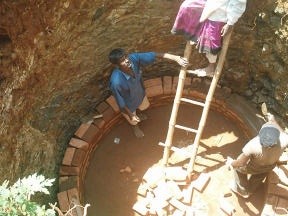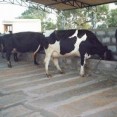To develop and operate a sustainable rural demonstration project: a community dairy biogas enterprise
 In this project which was implemented by the Asian Regional Energy Initiative of the International Energy Initiative (IEI) in an Indian village, biogas is generated for cooking and distributed in a micro-grid using cattle-dung from a co-operatively managed dairy, whose milk sales assist in financially supporting the operation.
The main objective was to promote rural enterprises that deliver improved household energy-based services and to sustain these services by integrating income-generation activities. The applied approach was unique because of its reach, financing mechanism, and innovative use of proven technologies and operational structures. Here, all families get better fuel at a co-operatively-agreed fee, rather than only those who can afford the increased cost.
In this project which was implemented by the Asian Regional Energy Initiative of the International Energy Initiative (IEI) in an Indian village, biogas is generated for cooking and distributed in a micro-grid using cattle-dung from a co-operatively managed dairy, whose milk sales assist in financially supporting the operation.
The main objective was to promote rural enterprises that deliver improved household energy-based services and to sustain these services by integrating income-generation activities. The applied approach was unique because of its reach, financing mechanism, and innovative use of proven technologies and operational structures. Here, all families get better fuel at a co-operatively-agreed fee, rather than only those who can afford the increased cost.
Background
In India, millions of rural families lack basic amenities including access to clean and efficient cooking fuels. To address these problems and improve the situation of the rural poor, this project was implemented in the Indian village of Chikkana Devara Hatti (238 inhabitants). The project aimed to demonstrate that a dairy biogas model, operated as a village-based multi-functional enterprise, could boost rural development. The enterprise consists of a dairy, for income generation and fuel and associated household biogas supply systems that replace the existing traditional biomass stoves. The dairy employs local people and the waste produced is used to fuel the biogas generation plant that delivers energy and fertiliser. The milk from the dairy is sold, supporting the operation financially. Before the biogas digesters were constructed, the rural families' energy requirements were estimated. As a result it was decided to build eight biogas digesters, which are shared between families. The villagers belong to a traditional shepherd tribe, called "Kadu Golla“, which is in need of socio-economic assistance.Technology, Operations and Maintenance
Establishing the dairy involved three main components: the construction of the buildings, the selection and purchase of cows from local farms and the arrangements for the daily operation of the enterprise. The dairy buildings can house a total of 112 cows, a water facility and a small office. Local people were employed and trained to undertake the work. To ensure responsibility, each employee was assigned a specific set of tasks and a retired teacher was appointed as a supervisor. Four months after the dairy construction started, work began on the biogas plants. The biogas requirement per family was estimated on the basis of the present biomass use and doubled to provide for increases in both residents and gas demand. Based on the pattern in which the houses are situated in the village, 8 biogas plants (6 of 8m3 capacity and 2 of 10m3 capacity) were installed. The cylindrical pit floating drum biogas digester model was chosen because it requires minimal maintenance. The construction of each biogas plant involved excavation works, masonry lining, fabrication and installation of the guide frame and gas holder, construction of the inlet tank and effluent outlet tank adjacent to each digester pit, and the piping connections for retrieval of the gas. The guide frames and the gasholders were fabricated outside the village. The local population was involved in the construction work but additional skilled labour had to be hired. One employee was trained in the operation and maintenance of each digester. Dung from the cattle sheds is collected regularly during the day and stored in large covered bins. To distribute the biogas, mini-grid piping systems were installed, connecting each digester with a group of households. A stop-valve is used to regulate the gas flow. Each kitchen was provided with a double- burner stainless steel stove to use the biogas as clean cooking fuel.Financial Issues and Management
The plan was for the project to be economically feasible, based on the expected operational outflows and inflows at market prices. The expected payback time for the basic construction costs (excluding management and monitoring) with/without interest (5%) was 4.4/3.7 years. An accounting system was established to manage the enterprise and the supervisor at the office records the daily inflows and outflows. During the project, the IEI undertook weekly verification and electronic recording of the relevant details. In addition, daily communication between the supervisor and IEI ensured that any problems could be dealt rapidly. At the end of the project, the operating costs were higher than expected due to increases in the price of grain and, therefore, of cattle-feed. The team handled this problem by replacing packaged feed with less expensive natural fodder. This replacement had to take place gradually because of the time required for the fodder crops to be grown and harvested.Environmental Issues
Biogas is preferable to traditional biomass stoves/fuel not only for its fuel efficiency, but also because it generates much lower GHG emissions. This project, which involved 238 inhabitants (47 households), resulted in a reduction in GHG emissions of around 456 t per year (CO2 equivalent). As the project was intended to be a demonstration project for further replication, the total emissions reduction will depend on the overall number of homes that become involved.Social Issues
The involvement of all the families and the co-operative operating structure were major success factors. The dairy farm and the biogas plants provide steady employment in an area where people are generally poorly educated and daily wages are uncertain. Employment, income and access to clean cooking fuels offer a rare opportunity to improve the village population's living conditions. It has been observed that other projects have been less successful in terms of public participation because of perceived inequalities (e.g. only those owning cattle had to supply dung), or because they have been restrictive on the basis of affordability (e.g. only those households who could afford it had the technology). The provision of clean cooking fuel reduces the time needed for fuelwood collection and also has positive health effects. Gas is provided during the common cooking times in the village (usually 3 hours in the morning and 1.5 hours in the evening, but adjusted according to the mutual convenience of the families sharing each plant).Results & Impacts
 The project enabled all families in the village, regardless of income or social strata, to have access to clean cooking fuel, based on the demand and suggestions from the users. The users were very satisfied with this service. Furthermore, employment and income opportunities were created within the dairy and for the operation and maintenance of the biogas plants.
The project enabled all families in the village, regardless of income or social strata, to have access to clean cooking fuel, based on the demand and suggestions from the users. The users were very satisfied with this service. Furthermore, employment and income opportunities were created within the dairy and for the operation and maintenance of the biogas plants.
Replicability
The replication potential of the project in India is high, as about 85% of rural homes still depend on biomass as cooking fuel. It is important to take local circumstances into account when establishing such a project. In order to increase interest in the model, the project has been promoted through the local media. However, the initial funding will remain a critical issue for new start-ups. In the future, financial support through the CDM mechanism could support larger-scale replication of the biogas rural energy development model.Lessons learned
Several factors should be noted when considering future projects. The construction and the training (technical and management) took much longer than predicted. Furthermore it would have been more efficient to begin constructing the cattle-sheds and biogas plants simultaneously, rather than consecutively; the cattle could then have been purchased in groups as each shed was completed, and corresponding waste-based biogas generation and distribution could have progressed in segments across the village. For large-scale replication, it might be preferable to have the option of some larger burner biogas stoves for community use, as the design used is only suitable for general household cooking. On a financial note, future projects should include a contingency allowance to help absorb external shocks such as price increases in basic construction materials. Furthermore, the financial balance of a project would be more sustainable if the input flows, such as fodder, were purchased locally and were, therefore, unaffected by national or global price increases. This type of local relationship also reinforces the social and environmental benefits.Projects with same technology
Renovating domestic biogas digesters and establishing post-installation services in Yunnan
To develop a sustainable solution for the reactivation of dysfunctional biogas digesters in Yunnan, China
Value-addition to food crop processing: Converting banana plant-waste to cooking-fuel
To provide clean cooking fuel at village level while improving income opportunities and giving appropriate treatment to crop residues
Projects in same country
Renewable Energy and Energy Efficiency in the Urban Health Sector - Bhubaneswar City Health Services
To improve health services for the poor in the city of Bhubaneswar, resulting in greater local socio-economic development and reduction in fuel poverty